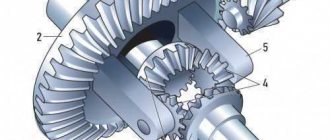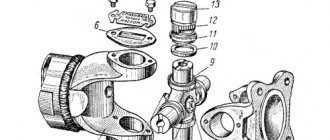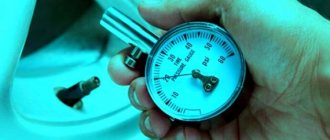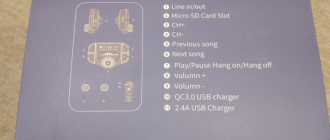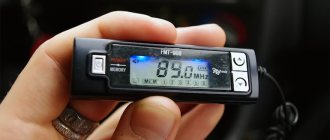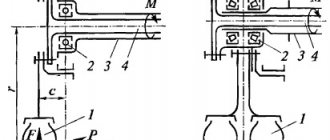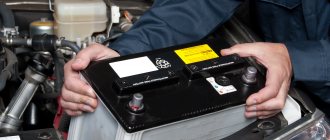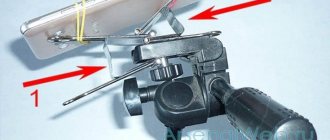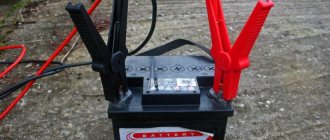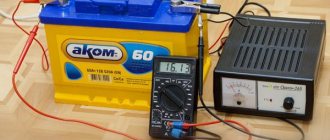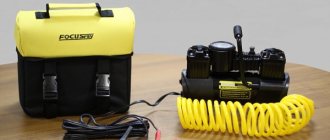For many motorists, the transponder is an unknown and completely incomprehensible device. Although in reality a huge number of drivers use such a gadget. Transponders are an integral part of satellite antennas, widely used in aviation, and they are necessary for the Ministry of Emergency Situations.
But if we talk about ordinary drivers, then for them the transponder opens up slightly different functions. There are special devices created for cars and motorists. They have certain properties, capabilities and undeniable advantages.
To use the capabilities of the device, you should understand its operating principle, the nuances of installation and further operation.
What is a toll road transponder?
From a practical point of view, a transponder is a technical means for transferring funds for using a toll road.
Unlike paying with cash or a bank card, it eliminates the need to stop at a security checkpoint. The sensor at the checkpoint reads the transponder signal, and funds in a certain amount are withdrawn from the car owner’s account.
Simply slow down in front of the barrier. Usually, reducing the speed to 10-20 km/h is enough, but sometimes a complete stop of the vehicle is required.
How to remove
The personalized transponder type is not tied to a specific vehicle, but to the account of a specific client. Therefore, it can be removed and used on another car. To remove the device from the glass, it is recommended to carefully peel it off using available tools that have sharp edges, for example, a knife. The dismantling process is carried out at a glass temperature of more than 20°C.
A transponder installed on a vehicle allows you to travel in comfort, quickly passing toll road checkpoints. But to avoid inconveniences associated with device failures, it must be installed correctly.
Did you manage to solve your problem using the recommendations from the article?
Yes!
46.24%
No. More answers required. I'll ask in the comments now.
37.86%
Partially. There are still questions. I'll write in the comments now.
15.9%
Voted: 346
How a car transponder works
The name of the device comes from two English verbs: to transmit and to respond. In appearance, it is just a small box that is attached to the windshield of a car, usually behind the rearview mirror.
Most of the time the device is not active, but turns on when it enters the field of the antenna located at the checkpoint. The sequence of events roughly looks like this:
- The transponder receives a signal from an antenna placed at the checkpoint and is activated.
- The transmitter at the checkpoint and the antenna determine an unoccupied channel through which information will be exchanged. A separate channel is necessary so that signals from different cars do not get mixed up.
- The transponder transmits the data necessary for payment via the selected secure channel. The information transmitted includes information about the user's contract, financial data for generating a receipt, information about the type of vehicle and information about the transponder itself.
- Then the software makes the transfer and the funds are debited from the driver’s account.
Under normal conditions, the entire process takes a fraction of a second, after which the device reports the completion of the operation using sound signals. Finally, it goes into sleep mode again until the next signal from the antenna at the gearbox.
In this case, the transponder is activated only for 30 seconds while passing a checkpoint. The radiation intensity is minimal, more than 10 times lower than that of a cell phone. The technology for “communication” between the transponder and equipment at the checkpoint is more like Wi-Fi.
Features of using transponders
In order for the device to work properly and not become “stupid” during the checkpoint, it must be installed on the windshield of the car. In this case, it must be attached to clean, dry glass so that the transponder does not fall off while driving. Overall installation is extremely simple:
- Choose a sunny day when the temperature outside is +15 degrees. Otherwise, there is a chance that the glue for mounting the device will not adhere.
- Wash and treat with alcohol the area where the transponder will be “planted”. Alcohol is needed for degreasing.
- Take the device itself out of the box. There will be an adhesive strip on one side. Remove it without touching the adhesive side with your fingers.
- Press the transponder onto the grease-free area and hold it for 10 seconds.
Depending on whether the device is glued to a truck or a passenger car, it must be mounted either at the top of the glass (on a passenger car) or at the bottom (on a truck). It goes without saying that the windshield wipers should not cover the transponder in the running or non-running position. This may interfere with the signal transmission, and then the reader will not be able to recognize your transponder. In this case, the barrier will not open and you will not be able to pass.
Differences between personalized and non-personalized transponder
There are two types of transponders - personalized and non-personalized. The difference between them is the provision of passport data during the execution of the contract. Personalized devices participate in loyalty programs and are attached to a single Personal account (several devices can be attached to one account).
Non-personalized transponders do not participate in the loyalty program, special offers and promotions. But their registration does not require personal data (passport details and contact information). It follows that:
- movements of your transponder are not associated with your personal data;
- you can freely transfer the device for use or even rent to third parties;
- All transactions are irreversible - money written off from the account cannot be returned.
Both types of transponder registration make sense, and each is suitable for specific purposes. For example, for occasional use of toll roads, you can purchase a non-personalized transponder. And the owner of an extensive fleet of vehicles is better off buying the required number of personalized transponders and linking them to a single account in order to control travel expenses.
Extended Warranty
The new service extends the transponder warranty by another 3 years. Now you can use the transponder for 5 years without fear for its performance.
Terms of service
1. The service is provided to personalized individuals and legal entities who own a transponder, the basic warranty period has not expired and is 2 years from the date of purchase. 2. The service can be purchased both at the time of purchase of the transponder and throughout the entire warranty period. 3. The validity period of the service is 3 years after the end of the main warranty period of the device.
Method of purchasing the service
1. You can purchase the service at any Sales and Service Center, at the Additional Office and at the Mobile Sales Point of Avtodor - Toll Roads LLC. 2. The service is purchased for one device. If you have two or more devices, the service must be purchased for each device separately. 3. You can apply for an extended warranty by filling out an application for the Transponder Use Agreement (DIT), indicating the personal account/agreement number and the individual transponder number (PAN).
Service cost
1. The cost of the service is 20% of the cost of the transponder model valid at the time of contacting the Sales and Service Center to purchase the service, in accordance with the Product Price List and. 2. The extended warranty service for transponders of different series is:
- Standard (transponders manufactured by Q-free) - 210 rubles, incl. VAT 20%,
- Premium (transponders manufactured by Kapsch) - 240 RUR, incl. VAT 20%,
- Limited edition “Nature of Russia” and “Cities of Russia” - 290 rubles, incl. VAT 20%.
Occurrence of a warranty case
1. If a warranty claim occurs, you must contact any Sales and Service Center with the device. The employee must verify that the transferred device meets the following conditions:
- the transponder has a marketable appearance;
- the transponder is not read by the antenna;
- An extended warranty service was previously purchased for this transponder and its period has not expired.
2. If one of the above conditions is not met, the case is considered non-warranty and you are offered to purchase a new device. If all conditions are met and the transponder fails through no fault of the owner, the device will be replaced with a new one of the same series. 3. After replacing the transponder, the new device is not covered by the established basic warranty period from the manufacturer of 2 years and is not provided with the opportunity to purchase. The warranty for the new transponder (after replacement) continues to be valid under the previously purchased extended warranty.
Additional restrictions
1. The service is provided within the framework of DIT: if, when purchasing the service, the User has a debt under this agreement, he must pay it off and only after that will be able to purchase an Extended Warranty for the transponder. 2. If, when returning a transponder, there is no holder, then the CC&O employee gives the new transponder to the user without a holder. 3. If the user returns a Standard series transponder, but there is no such series available at the moment, the user is asked to hand over (return) the transponder as a complete set (with holder). In this case, the Point of Sales employee hands over the Premium series transponder to the user, and vice versa. 4. The exception is transponders of the Limited Edition series: replacement is made with a similar series. In this case, the user is asked to select any image he likes on the front side of the device from those available.
How to buy a transponder for toll roads
You can buy your transponder in the official Avtodor online store, sales points directly on toll roads and branches of the relevant companies (WHSD, SZKK and Avtodor). The purchase process is accompanied by the conclusion of an appropriate agreement on the provision of services related to the use of the transponder.
The package of documents for individuals who want to purchase a non-personalized transponder boils down to a standard application. To purchase a personalized device, you will need to attach the original and a copy of a document confirming your identity and contact information for feedback (mobile phone number and email address).
Traditionally, bureaucratic processes are a little more complicated for legal entities. The package of documents is more complex and includes:
- documentary evidence of registration of an individual entrepreneur or legal entity;
- confirmation of registration of a registered individual entrepreneur or legal entity. persons for tax registration;
- a letter on official letterhead or simply certified by a seal, but which indicates the bank details of the account from which payment will be withdrawn;
- an extract from the register of individual entrepreneurs and legal entities less than 30 days old (otherwise it is invalid).
On the other hand, after concluding an agreement, it will be possible to connect many transponders to a personal account registered in the name of a legal entity or individual entrepreneur.
What types of transponders are there?
There are four types of transponders - T-Pass, “15-58 M-11”, “Western High-Speed Diameter” and “Main Road”. Each of them will be beneficial on a certain toll road.
For example, the “15-58 M-11” transponder will give a discount on travel on the M-11 “Neva” highway, and the “Main Road” transponder will give a discount on sections of the Northern Bypass of Odintsovo, the M-11 highway and the Western High-Speed Diameter in St. Petersburg.
I used the T-Pass transponder because it provided a discount on the roads I needed on the way to the sea:
- M-4 “Don” - from 21 to 211 km;
- M-11 "Neva" - from 258 to 334 km.
The T-Pass transponder also gives a discount on the M-3 Ukraine highway - from 124 to 194 km - but it was not included in my route.
The transponder can be purchased or rented. My family and I drive on toll roads once a year, so it’s cheaper for us to rent. But for those who constantly drive on toll roads, it is still more profitable to buy a transponder.
How to check and top up your transponder balance
To replenish the personal account to which the transponder applies for payment, there are many modern methods of transferring funds. First of all, this is a personal account on the website of the company that provided the transponder. In this case, payment can be made using electronic payment systems (Yandex.Money, Qiwi, Webmoney and others).
The list of possible ways to replenish your balance includes online banking from Sberbank, cash at transponder sales points, Qiwi terminals at partner gas stations and others. The current account status, details of payments made and other information are available in the same personal account or in the latest applications (for now Avtodor and WHSD have them).
Thus, in terms of monitoring and use of funds, transponders represent a completely modern technology. In fact, it would be strange if companies providing such services did not take care of the comfort of their clients.
How to use a transponder on a toll road
Operation of the transponder is extremely simple. After concluding the contract, the client receives a device ready for use. All you have to do is attach the transponder to the windshield of the car and periodically replenish the balance. The rest is a matter of automation.
Installing the transponder is extremely simple:
- Select a mounting location (on the inside of the windshield). For passenger cars - behind the rear view glass, for trucks - at the bottom of the glass, between the windshield wipers.
- Degrease the area of future fastening.
- Remove the protective film from the adhesive layer on the “leg”.
- Attach the transponder to the glass as close to a horizontal position as possible. To reliably glue the bracket, the device can be temporarily removed from it.
If the transponder is installed in another location, normal communication between the device and the transmitting antenna is not guaranteed. But even in case of problems with automatic payment, travel can always be paid using traditional methods - cash or bank card.
After these simple manipulations, the device is ready for use. You can monitor your balance from a special application and top up your account using the methods described above. Otherwise, the payment process is fully automated, and occurs when the transponder falls within the range of the receiving antenna at the checkpoint. It is enough to slow down a little until the barrier opens, and the transponder will indicate the completion of payment with a sound signal.
If the transponder stops working due to a discharged battery, it will not be possible to recharge or replace the battery. The service provider replaces dead devices with new ones. But, taking into account the peculiarities of the operation of the entire system, one charge is enough for a fairly long period of operation.
Video on the topic
Related publications
- Category A1 on a driver's license: what is it?
- DSAGO: what is it and why is it needed?
- What do red license plates mean on a car in Russia?
- Category Be on a driver's license: what is it?
Leave a review
Cancel reply

